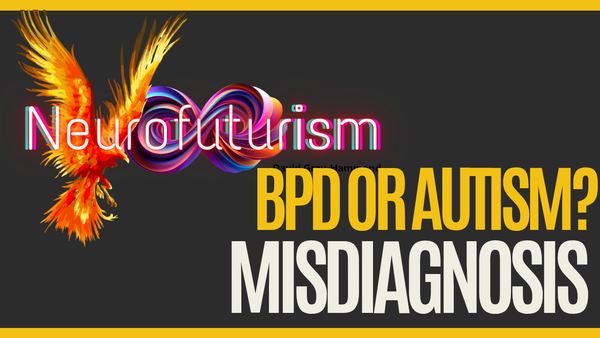CAMHS and the loss of Jennifer ('Jen') Chalkley
The following article is a response to the findings that failures by Surrey and Borders Child and Adolescent Mental Health Services (CAMHS) contributed to the death of a 17 yeard old Autistic and ADHD person.

Recently I have been made aware of a coroners inquest into the death of an Autistic and ADHD 17 year old called Jennifer Chalkley, also known as Jen. I felt a particular need to respond to this having recently published two reports on Child and Adolescent Mental Health Services (CAMHS) and noting that CAMHS have been implicated in the death of this person. For reference, you can find the reports using the buttons below. The information I have on this case comes from a press release by Doughty Street Chambers.
Who was Jennifer Chalkley (AKA Jen)?
Jen was an Autistic and ADHD 17 year old. She was diagnosed ADHD at the age of 10, and Autistic at the age of 11. One of my frustrations with releases such as this is that people are reduced to their struggles. Yes, it is notable that Jen had special educational needs, she experience "excessive anxiety, low mood, and emotional dysregulation which she suffered periodically" (Sikand, 2024). Jen was a person, more than just her struggle, I can imagine that like many of us, she had hopes and dreams, a family who loved her, and a great deal of potential. We are more than our struggles, and we deserve to be known for the light we bring to people's lives.
What happened and how are CAMHS implicated?
On the 12th of October, 2021, Jen took her own life at home in surrey. CAMHS in particular are implicated for systemic and professional failings that the coroner believes could have mitigated the risk of this happening. Sadly, this is becoming a story we are all too familiar with when it comes to the provision of mental health services in the UK. Richard Travers, Senior Coroner, found multiple failures by Surrey and Borders CAMHS.
How did CAMHS fail Jennifer Chalkley?
As I note the failures highlighted by the inquest, I feel it would be helpful to relate them to the findings of the two reports I authored as well as previous writing. I believe this may help give some context.
"She [Jen] was twice discharged by CAMHS over a three-year period, having not been assessed, diagnosed, or having had any therapeutic treatment or her medication reviewed."
This is a matter that was reflected in the qualitative report of people's experiences with CAMHS (Gray-Hammond, 2024a). One of the quotes from the report reads in an all too familiar manner:
"My granddaughter is suffering on a daily basis and CAMHS have refused to engage with emotional wellbeing."
Jen's case, then, highlights the life threatening consequences of rejected referrals.
"Jen’s last discharge from CAMHS took place three months before her death, in June 2021, after a 15-minute audio call, by practitioners who had not properly reviewed her medical history."
This reflects my own experience as a neurodivergent teenager, where at the age of 15, deep in crisis, I only received a 5 minute appointment with a psychiatrist who immediately discharged me. It scares me to think how close I came to sharing the same fate as Jen.
Perhaps most stark, and requiring no commentary is this quote from the press release:
"He [the coroner] found that the two practitioners who agreed to discharge Jen gave dishonest evidence and tried to mislead him in evidence"
Further insights into CAMHS failure
"CAMHS lost sight of the vital role that it should have played in managing the risk to Jen’s life."
The quantitative CAMHS report (Gray-Hammond, 2024b) found that only 22.2% of survey respondents felt that CAMHS were attentive and supportive of service users. It also found that only 36.2% believed that service users were treated with dignity and respect. I believe that these statistics are telling a worrying story when aligned with the coroners finding that they lost sight of their role.
"There was pressure on CAMHS practitioners to refer patients away from the service and discharge them, rather than treat them, which was probably driven by the level of demand CAMHS faced"
This finding by the coroner is a sentiment reflected by the entire Autistic community. CAMHS heavily gatekeep their services, and Autistic children and young people are the first to fall foul of this. Only 15.6% of survey respondents felt that CAMHS was easy and understandable to access Gray-Hammond, 2024b). Coupled with the coroners findings one could infer that accessibility is obscured in order to keep people away from an overstretched service.
A final note to CAMHS keeping out service users is the denial of suicide risk. Clearly this had heartbreaking consequences for Jennifer Chalkley, and is further reflected by the qualitative CAMHS report (Gray-Hammond, 2024a):
“Repeatedly told her whilst she had ligatured and stated she wanted to die that she was not suicidal”
While CAMHS rebuff service users, people are dying. This needs to change.
Final Thoughts
I did not know Jen, but I know her story all too well. It is the same story that I have heard happening to Autistic children and young people over and over. It is the reason why I write about CAMHS and campaign to change them. I am terrified that one day I could be writing about my own child, and I can not sit quietly while they place people like Jennifer Chalkley at risk. Jen deserved better, all Autistic children and young people deserve better. Lets stop the snuffing out of young potential, and make a world where our young people can lead happy and supported lives.


